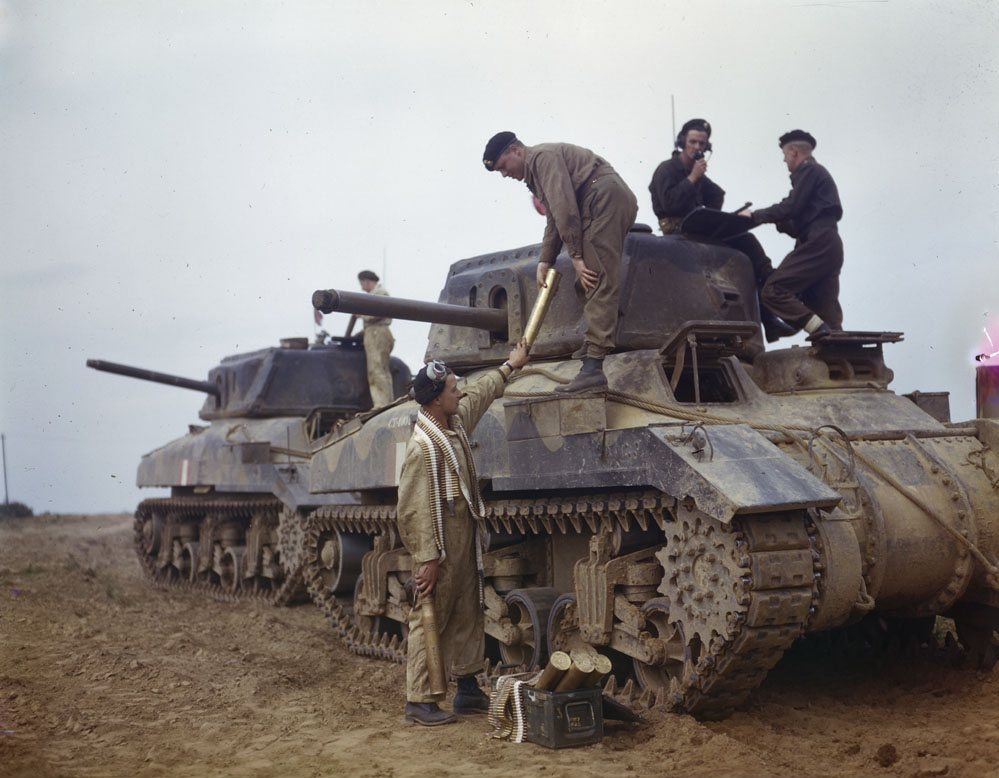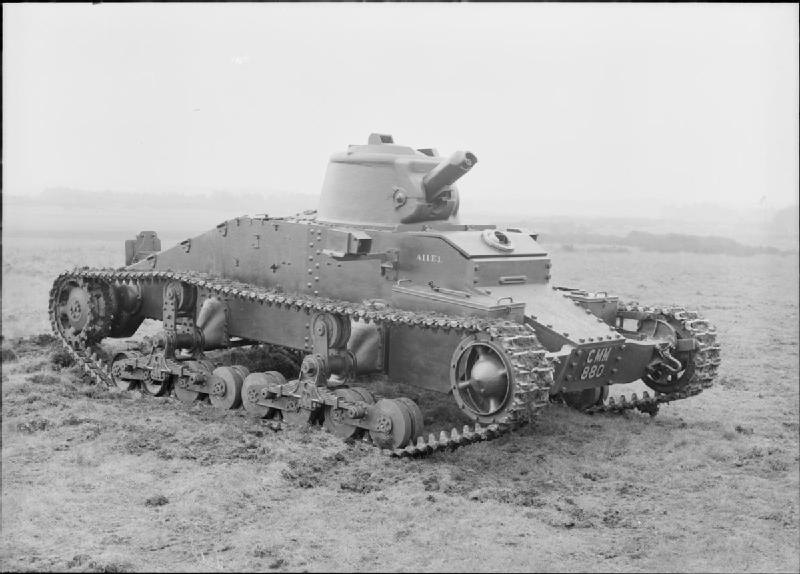|
Ram Tank
The Tank, Cruiser, Ram was a cruiser tank designed and built by Canada in the Second World War, based on the U.S. M3 Medium tank chassis. Due to standardization on the American Sherman tank for frontline units, it was used exclusively for training purposes and was never used in combat as a gun tank. The chassis was used for several other combat roles however, such as a flamethrower tank, observation post, and armoured personnel carrier. Development Even before the loss of the majority of the United Kingdom's tank force in France in 1940 after Dunkirk, it was recognised that tank production in the UK at the start of the war was insufficient and capacity in the US was taken for British needs.Ellis and Chamberlain p3 So it was necessary that if Canada was to equip with tanks they would have to be manufactured locally.Ellis and Chamberlain In June 1940 the Canadian Pacific Railway's Angus Shops in Montreal, as the only large firm with spare capacity, had received a contr ... [...More Info...] [...Related Items...] OR: [Wikipedia] [Google] [Baidu] |
CFB Borden
Canadian Forces Base Borden (also CFB Borden, French: Base des Forces canadiennes Borden or BFC Borden), formerly RCAF Station Borden, is a large Canadian Forces base located in Ontario. The historic birthplace of the Royal Canadian Air Force, CFB Borden is home to the largest training wing in the Canadian Armed Forces. The base is run by Canadian Forces Support Training Group (CFSTG) and reports to the Canadian Defence Academy (CDA) in Kingston. History At the height of the First World War, the Borden Military Camp opened at a location on a glacial moraine west of Barrie in 1916 to train units for the Canadian Expeditionary Force. It was named for Sir Frederick William Borden, former Minister of Militia. In May 1916, the Barrie and Collingwood companies of the 157th Battalion (Simcoe Foresters), CEF (perpetuated today by The Grey and Simcoe Foresters), under the command of Lieutenant-Colonel D.H. MacLaren, began construction of the camp. Camp Borden was selected in 1917 f ... [...More Info...] [...Related Items...] OR: [Wikipedia] [Google] [Baidu] |
United Kingdom
The United Kingdom of Great Britain and Northern Ireland, commonly known as the United Kingdom (UK) or Britain, is a country in Europe, off the north-western coast of the European mainland, continental mainland. It comprises England, Scotland, Wales and Northern Ireland. The United Kingdom includes the island of Great Britain, the north-eastern part of the island of Ireland, and many List of islands of the United Kingdom, smaller islands within the British Isles. Northern Ireland shares Republic of Ireland–United Kingdom border, a land border with the Republic of Ireland; otherwise, the United Kingdom is surrounded by the Atlantic Ocean, the North Sea, the English Channel, the Celtic Sea and the Irish Sea. The total area of the United Kingdom is , with an estimated 2020 population of more than 67 million people. The United Kingdom has evolved from a series of annexations, unions and separations of constituent countries over several hundred years. The Treaty of Union between ... [...More Info...] [...Related Items...] OR: [Wikipedia] [Google] [Baidu] |
Observation Post
An observation post (commonly abbreviated OP), temporary or fixed, is a position from which soldiers can watch enemy movements, to warn of approaching soldiers (such as in trench warfare), or to direct fire. In strict military terminology, an observation post is ''any'' preselected position from which observations are to be made - this may include very temporary installations such as a vehicle parked as a roadside checkpoint, or even an airborne aircraft. (from a DoD news briefing. Accessed 2008-06-21.) Operation When selecting a (temporary) observation post, trained troops are to avoid ...[...More Info...] [...Related Items...] OR: [Wikipedia] [Google] [Baidu] |
Sherman Tank
} The M4 Sherman, officially Medium Tank, M4, was the most widely used medium tank by the United States and Western Allies in World War II. The M4 Sherman proved to be reliable, relatively cheap to produce, and available in great numbers. It was also the basis of several other armored fighting vehicles including self-propelled artillery, tank destroyers, and armored recovery vehicles. Tens of thousands were distributed through the Lend-Lease program to the British Commonwealth and Soviet Union. The tank was named by the British after the American Civil War General William Tecumseh Sherman. The M4 Sherman evolved from the M3 Medium Tank, which for speed of development had its main armament in a side sponson mount. The M4 retained much of the previous mechanical design, but moved the main 75 mm gun into a fully traversing central turret. One feature, a one-axis gyrostabilizer, was not precise enough to allow firing when moving but did help keep the gun aimed in roughly t ... [...More Info...] [...Related Items...] OR: [Wikipedia] [Google] [Baidu] |
Ordnance QF 2 Pounder
The Ordnance QF 2-pounder ( QF denoting "quick firing"), or simply "2 pounder gun", was a British anti-tank gun and vehicle-mounted gun employed in the Second World War. It was the main anti-tank weapon of the artillery units in the Battle of France and, due to the need to rearm quickly after the Dunkirk evacuation, remained in service during the North African campaign. In its vehicle-mounted variant the 2-pounder was a common main gun on British tanks early in World War II, as well as being a typical main armament of armoured cars, such as the Daimler, throughout the war. As the armour protection of Axis tanks improved, the 2-pounder lost effectiveness and it was gradually replaced by the 57 mm QF 6-pounder starting in 1942. It equipped infantry battalion anti-tank platoons replacing their anti-tank rifles until in turn replaced by 6-pounders but remained in service until the end of the war. This QF 2-pounder was distinctly different from the QF 2 pounder "pom-pom" gun ... [...More Info...] [...Related Items...] OR: [Wikipedia] [Google] [Baidu] |
Steel Casting
Steel casting is a specialized form of casting involving various types of steel cast to either final/net or near-net shape. Steel castings are used when iron castings cannot deliver enough strength or shock resistance.Oberg, p. 1332 Examples of items that are steel castings include: hydroelectric turbine wheels, forging presses, gears, railroad truck frames, valve bodies, pump casings, mining machinery, marine equipment, turbocharger turbines and engine cylinder blocks. Steel castings are categorized into two general groups: carbon steels and alloy steels. Steel castability Steel is more difficult to cast than iron. It has a higher melting point and greater shrinkage rate, which requires consideration during mold design. Risers should be given more capacity to draw from as the metal cools and shrinks. Attention should be paid to the thickness of mold cavities, as thinner areas will cool quicker than thicker areas, which can create internal stress points that can lead to ... [...More Info...] [...Related Items...] OR: [Wikipedia] [Google] [Baidu] |
American Locomotive Company
The American Locomotive Company (often shortened to ALCO, ALCo or Alco) was an American manufacturer of locomotives, diesel generators, steel, and tanks that operated from 1901 to 1969. The company was formed by the merger of seven smaller locomotive manufacturers and Schenectady Locomotive Engine Manufactory of Schenectady, New York. A subsidiary, American Locomotive Automobile Company, designed and manufactured automobiles under the Alco brand from 1905 to 1913. ALCO also produced nuclear reactors from 1954 to 1962. The company changed its name to Alco Products, Incorporated in 1955. In 1964, the Worthington Corporation acquired the company. The company went out of business in 1969. The ALCO name is currently being used by Fairbanks Morse Engine for their FM, ALCO line. Foundation and early history The company was created in 1901 from the merger of seven smaller locomotive manufacturers with Schenectady Locomotive Engine Manufactory of Schenectady, New York: * Brooks Loco ... [...More Info...] [...Related Items...] OR: [Wikipedia] [Google] [Baidu] |
Longue Pointe
Longue Pointe (French for "Long Point") is a place located in northern Quebec, Canada. It is part of the Cree Nation of Chisasibi Category I Land (land for exclusive use by Cree) but has no permanent population. It is used by both Cree and Inuit natives as a harbour for their fishing boats. It is among the furthest northern point reached by road in Quebec, extending from the James Bay Road (north of the Grand River). Only the Trans-Taiga Road extends farther to the north. Location Longue Pointe is about north-west from Chisasibi on James Bay, and located on the border of Quebec and Nunavut Territory.https://maps.google.com/maps/mm?ie=UTF8&hl=en&ll=53.974641,-79.079053&spn=0.008771,0.019011&t=h&z=16&lci=lmc:wikipedia_en It is accessible by a gravel road from Hydro-Québec's La Grande-1 generating station, on the Grand River. The area overlooks James Bay (about south from where it joins Hudson Bay). Early European fur traders frequented these parts, around the start of ... [...More Info...] [...Related Items...] OR: [Wikipedia] [Google] [Baidu] |
Soviet Union
The Soviet Union,. officially the Union of Soviet Socialist Republics. (USSR),. was a List of former transcontinental countries#Since 1700, transcontinental country that spanned much of Eurasia from 1922 to 1991. A flagship communist state, it was nominally a Federation, federal union of Republics of the Soviet Union, fifteen national republics; in practice, both Government of the Soviet Union, its government and Economy of the Soviet Union, its economy were highly Soviet-type economic planning, centralized until its final years. It was a one-party state governed by the Communist Party of the Soviet Union, with the city of Moscow serving as its capital as well as that of its largest and most populous republic: the Russian Soviet Federative Socialist Republic, Russian SFSR. Other major cities included Saint Petersburg, Leningrad (Russian SFSR), Kyiv, Kiev (Ukrainian Soviet Socialist Republic, Ukrainian SSR), Minsk (Byelorussian Soviet Socialist Republic, Byelorussian SSR), Tas ... [...More Info...] [...Related Items...] OR: [Wikipedia] [Google] [Baidu] |
Infantry Tank
The infantry tank was a concept developed by the United Kingdom and France in the years leading up to World War II. Infantry tanks were designed to support infantrymen in an attack. To achieve this, the vehicles were generally heavily armoured to allow them to operate in close concert with infantry even under heavy fire. The extra armour came at the expense of speed, which was not an issue when supporting relatively slow-moving foot soldiers. Once an attack supported by infantry tanks had broken through heavily defended areas in the enemy lines, faster tanks such as cruiser or light tanks were expected to use their higher speed and longer range to operate far behind the front and cut lines of supply and communications. The infantry tank was superseded by the "Universal Tank" concept which could adequately perform the roles of both infantry and cruiser tank, as represented by the Centurion which replaced both the Churchill and any medium or cruiser tanks then in service. This led ... [...More Info...] [...Related Items...] OR: [Wikipedia] [Google] [Baidu] |





